
The selection and especially the stabilization of personnel capital should be a key area of interest for all senior managers of security forces. The motivation of police officers is a key element for the efficient and professional performance of their work. One of the most important functional elements of the organization is a quality analysis of the process of acquiring new employees. Given that the Police of the Czech Republic has been dealing with the problem of replenishing the staff for a long time, this contribution is focused on the motivational factors of members of the Police of the Czech Republic, which have a significant effect on personnel stability and also on properly targeted personnel recruitment. The article presents the results of a research investigation in which police officers from the Czech Republic and the Slovak Republic participated.
Copyright © 2024 Jan Bajura, Lukáš Habich, Tomáš Najman and Jiří Víšek. This is an open access article distributed under the Creative Commons Attribution License, which permits unrestricted use, distribution, and reproduction in any medium, provided the original work is properly cited.
nsuring public order and the safety of the population is a globally significant task of every state, while the field of security and its protection is a very dynamic and technologically demanding industry, which stems mainly from the gradual transfer of selected types of crime to cyberspace.
The security situation is constantly changing and evolving, so it is necessary to be adequately prepared and adequately react to it, adapt and create new tools and means to make the overall environment of the company as secure as possible and reduce threats to the lowest risk. Security as such can generally be divided into internal and external. Both of these components affect the security situation of the state. The state has to fulfill certain basic obligations that are directly related to ensuring security [1].
The evolving and frequently changing forms and methods of crime are a critical challenge for all security actors in every country. In the environment of the Czech Republic, this issue is primarily dealt with by the Police of the Czech Republic, whose task is to detect, investigate and prevent all types of criminal activity. Just like any other organization, especially if it is a security force, the Police of the Czech Republic needs not only adequate technological equipment that corresponds to modern trends, but also qualified and sufficient personnel capacity to perform all tasks in the field of detection, investigation and prevention of criminal activity.
The performance of the profession of a police officer is specific compared to most professions due to a number of special authorizations that are granted to the police and its members and which may interfere with the rights and freedoms of other persons. Society generally establishes the police to provide a service to it, in the form of impartial and dispassionate law enforcement. One of the inherent characteristics of the police should therefore be its social neutrality. The police and individual police officers must not show any bias, for example political, religious, racial or ethnic or similar [2]. Constitutional Act No. 110/1998 Coll., on security, states in Article 3, paragraph 1: “The security of the Czech Republic is ensured by the armed forces, armed security forces, rescue forces and emergency services.”
The selection and especially the stabilization of personnel capital should be a key area of interest for all senior managers of security forces. However, the competitiveness of security force recruitment is not the same in every country and time period. The Czech Republic is among the countries that are currently reacting to the unfavorable development of the economic and financial situation by extensive consolidation of public finances, which is of course also reflected in the economic sphere of the security forces. Stagnation or even a possible reduction in the volume of financial resources intended for the service income of members of the security forces does not correspond to the parallel increase in average wages in the private sector. Such a situation, however, can cause an outflow of possible applicants for a job with the police to private sector employers.
As of January 1, 2023, the total registered number of members of the Police of the Czech Republic was 39,422. According to the statistical data of the Police of the Czech Republic, in 2022, the highest proportion of applicants accepted into the service of a member of the Police of the Czech Republic were male persons aged 20-29 with a completed secondary education with a school-leaving exam (see chart no. 1 and chart no. 2). It is therefore a group of people representing a dominant source of potential candidates for service at the police station, which should be reflected in the recruitment strategy.
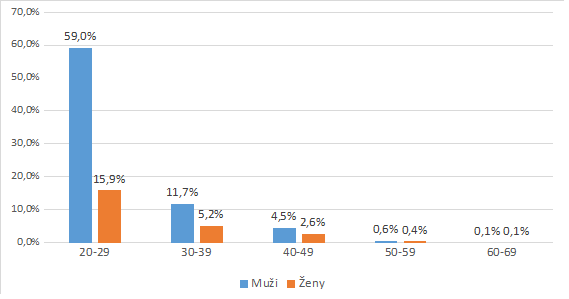
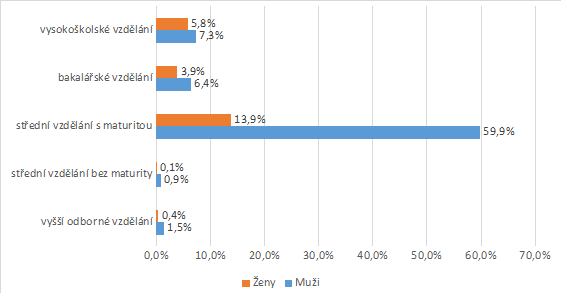
On the basis of these facts, it is necessary that the interest of the police and other security forces is directed towards maintaining and developing the personnel recruitment of high-quality individuals with optimal personal prerequisites for work in the field of ensuring security and to stabilize and maintain existing members of the security forces, whose experience is a valuable asset for any security choir. In this context, the identification of a person for the performance of a certain profession is also important, the motivation to perform such work is related to this, which in subsequent practice is a significant added value and a guarantee that the relevant position will be filled by a quality employee [3]. At the same time, a number of questions arise aimed at the correct setting of the recruitment policy, the creation of suitable conditions for the performance of the service and the motivation of potential and existing members to work for the security corps.
This article deals with the issue of motivation to work for the police and the factors that influence it in more detail. The Police Academy of the Czech Republic in Prague carried out a research investigation as part of a partial research task entitled “Analysis and expected development of the competences of the Police of the Czech Republic and police security entities in selected areas”, the aim of which was to find out what motivational factors influenced the respondents’ decision to become a member of the Czech Police of the Republic and what are their attitudes towards this profession.
The authors chose a quantitative research technique – a questionnaire survey – to find out important motivational factors influencing the entry into the service of a member of the Police of the Czech Republic and attitudes towards the long-term performance of the police profession. Respondents were approached on the basis of availability, according to the selection key – (1) newly appointed members of the Police of the Czech Republic who are simultaneously studying a university bachelor’s degree program at the Police Academy of the Czech Republic in Prague and (2) newly appointed members of the Police of the Czech Republic who are simultaneously preparing for service as part of the basic qualification course “Basic vocational training”, newly joined members of the Police Force of the Slovak Republic, who are also preparing for service at the Academy of the Police Force in Bratislava (Slovak Republic). A total of 159 questionnaires were distributed in person by trained interviewers. A total of 159 evaluable questionnaires were collected, so the return rate was 100%. Of these, there were 44 respondents from group (1) and 115 respondents from group (2). (Note: Group No. 1 are members of the Police of the Czech Republic studying at the Police Academy in a bachelor’s study program (full-time study) and Group No. 2 are members of the Police of the Czech Republic and members of the police force of the Slovak Republic who perform service income for up to 3 years of service.) There were a total of 106 male respondents and 53 female respondents.
As a basic criterion for verifying research assumptions for categorized variables, the material significance of a real difference at the level of 10% (note: Previous experience from data analysis shows that the detected minimum 10% difference in line relative frequencies is usually accompanied by the minimum size of Cohen’s index “w” at the level of w \(\geq\) 0.10.) between the adequate line relative frequencies within the compared nodes in the classification trees (the same lines at the end nodes of the classification tree, which have the greatest heuristic significance) can be chosen. The basic criterion will be supplemented by a suitable auxiliary indicator that measures the degree of asymmetric statistical association between the categorized variables [4]. For this, association indicators based on proportional error reduction (PRE) models, which are accurate and user-friendly, are most suitable [4].
Considering the nature of the analyzed data, an asymmetric coefficient will be used to determine the influence of the independent nominal variable on the dependent nominal variable – this is Goodman’s and Kruskal’s tau. The given coefficient tells how much percent of the variance in the dependent variable is explained by the influence of the independent variable. (note: The term “explanation” must be understood in the sense of reducing the statistical dispersion of the data, not in the sense of a causal interpretation (which may not apply). Or, in other words, on the ratio of the reduction of the variability of one variable in the classes of the other variable.) The answer is always expressed as a proportion ranging from zero to one, or a percentage ranging from 0% to 100%. Similarly, the influence of the independent nominal variable on the dependent ordinal variable is measured by the asymmetric coefficient \(\beta\), and the influence of the independent ordinal variable on the dependent ordinal variable is determined by the asymmetric coefficient Somers delta. The possibility of expressing the asymmetric relationship as a percentage for the above-mentioned coefficients (GK tau, coefficient \(\beta\) and Somers’ delta) oriented to the explanation of dispersion is a very useful and understandable procedure for researchers. These rates have the character of objectively significant indicators. In practical analysis, in the search for truly acceptable effects, the so-called effect of size analysis is increasingly coming to the fore. Petr Soukup provides a relatively clear definition of material significance:
“The objective significance of the result means that the measured difference or the established connection is important for scientific knowledge or practical purposes. In contrast to statistical significance, which determines whether the found result is generalizable (i.e. whether it is not caused by chance influencing the selection of units or experimental conditions), substantive significance tells us whether it makes sense to talk about the result at all and whether it has practical consequences (including consequences for science itself). In order to find out whether the result is materially significant, and if so, then how much, it is necessary to have certain indicators, measures of material significance” [5].
In his monograph, author defined the point estimates of an acceptable materially significant effect explaining variance for the PRE \(\Omega\)2 measure as follows: 0.01 – small effect; 0.059 – medium effect; 0.138 – large effect) [6]. The w2 coefficient, as an indicator of relative factual significance independent of different sampling ranges (N), is also of fundamental importance for comparing results from different research studies. So also where it is a question of synthesizing a number of results from many researches, articles, etc., in so-called meta-analytical studies. There it is not possible to simply state statistical significance or non-significance, or compare t-test values, etc., precisely because of the incomparability of different researches with different ranges of N samples.

With values of 0.01 (small effect); 0.06 (medium effect) and 0.14 (large effect) offer certain comparative limits even for the indicated coefficient of asymmetric association PRE of Goodman and Kruskal’s tau.
At this point, it is also necessary to mention another index, which bears the designation Cohen’s w. It is intended only for categorized variables of a nominal nature. Cohen’s w [7] interval values for small, medium and large effects can be derived from the embedded table in the text. However, with regard to the symmetrical form of this index, its use should be understood as auxiliary, only for a certain comparison with the adequate coefficient of proportional reduction of error (PRE) for nominal variables – the asymmetric coefficient of association Goodman-Kruskal’s tau. The starting point for defining Cohen’s w is the calculation of the coefficient phi ( ), which measures the strength of association in a table that has two rows and two columns, i.e. one degree of freedom (df=1).
IBM SPSS V13 software was used to create first-level classification tables. The IBM SPSS Statistics V26 program was used to create the classification trees – the decision trees module. Its advantage is combining classes into one for independent variables, if they have a homogeneous character (similar answers in the classes of independent variables to the given question). The values of Goodman’s and Kruskal’s tau and Cohen’s w index (fi) were also determined using the IBM SPSS Statistics V26 program (contingency tables), using the bootstrap method (which in our case means 1000 selections with returns from the given sample set (159 respondents) and determining the bootstrap confidence interval for the estimated value of Goodman’s and Kruskal’s tau asymmetric coefficient.
Question no. 1: Do I want to combine my professional life with the profession of a police officer?
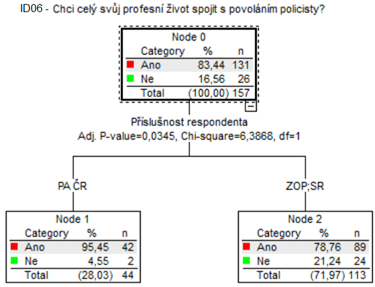
A materially significantly different relative frequency of answers was found for the affiliation of the sample group respondents to the given question. The difference is more than the defined 10% in the relative frequencies of responses. The value of Goodman and Kruskal’s asymmetric tau coefficient is 5.4% of the explained variance. It follows from the above that the relationship between the two classes of respondents’ affiliation (PA CR on the one hand; ZOP and SR on the other) and their answer to question ID04 has the character of a statistical nominal relationship. It can be concluded that 5.4% of the explained variance of the nominal variable (I want to connect my entire professional life with the profession of a police officer) is caused by the two classes of the nominal variable of the respondent’s affiliation.
The indicated value of the asymmetric coefficient of 0.054 almost reaches the interval of “medium materially significant association”. An acceptable materially significant influence of the independent variable was found for the given dependent variable.
Question no. 2: Within the police force, my goal is to serve in a basic unit (district/local department)
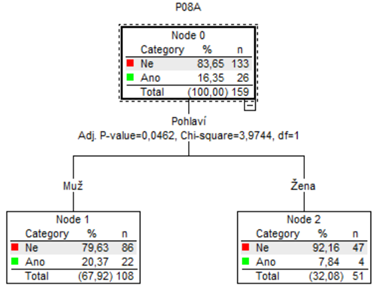
Regarding the gender of the respondents of the sample group, a materially significantly different relative frequency of answers to the given question was found. The difference is more than the defined 10% in the relative frequencies of responses. The value of Goodman and Kruskal’s asymmetric tau coefficient is 2.5% of the explained variance. It follows from the above that the relationship between the respondents’ gender and their answer to question P08a has the character of a statistical nominal relationship. It can be concluded that 2.5% of the explained variance of the nominal variable (Within the police, my aim is to serve in a basic unit (district/local department) is due to the two classes of the nominal variable (gender – male and female). The reported skewness coefficient value of 0.025 exceeds “small materially significant association” interval.
An acceptable materially significant influence of the independent variable was found for the given dependent variable.
Question no. 3: I started thinking about working for the police because I was inspired by my studies in high school
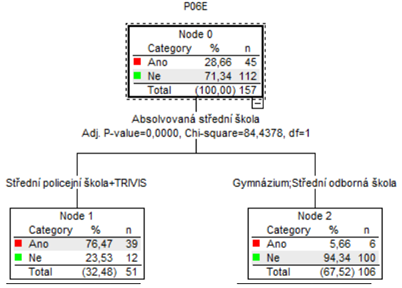
A materially significantly different relative frequency of answers was found for the affiliation of the sample group respondents to the given question. The difference is more than the defined 10% in the relative frequencies of responses. The value of Goodman and Kruskal’s asymmetric tau coefficient is 53.8% of the explained variance. It follows from the above that the relationship between the two classes of respondents’ education (secondary police school+TRIVIS on the one hand and gymnasium and secondary vocational school on the other) and their answer to question P06e has the character of a statistical nominal relationship. It can be concluded that 53.8% of the explained variance of the nominal variable (I started thinking about working for the police because I was inspired by my studies in high school) is due to the two classes of the nominal variable of the respondent’s educational institution. The indicated value of the asymmetric coefficient of 0.538 very significantly exceeds the interval of “large materially significant association”.
An acceptable materially significant influence of the independent variable was found for the given dependent variable.
Question no. 4: For me, the biggest motivation for working for the police is long-term job stability
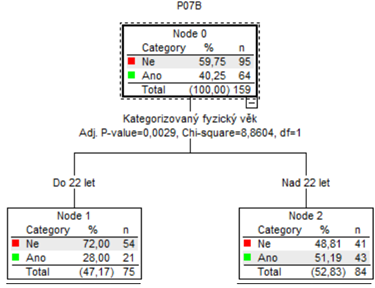
Regarding the categorized physical age of the respondents of the sample group, a materially significantly different relative frequency of answers was found to the given question. The difference is more than the defined 10% in the relative frequencies of responses. The value of Goodman and Kruskal’s asymmetric tau coefficient is 5.6% of the explained variance. It follows from the above that the relationship between the two classes of respondents’ categorized physical age (under 22 years; over 22 years) and their answer to question P07b has the character of a statistical nominal relationship. It can be concluded that 5.6% of the explained variance of the nominal variable (For me, the biggest motivation for working in the police is long-term job stability) is caused by two classes of the nominal variable of categorized physical age. The indicated value of the asymmetric coefficient of 0.056 reaches the interval of “almost moderate materially significant association”. An acceptable materially significant influence of the independent variable was found for the given dependent variable.
Question no. 5: For me, the biggest motivation for working for the police is a steady income

A materially significantly different relative frequency of answers was found for the affiliation of the sample group respondents to the given question. The difference is more than the defined 10% in the relative frequencies of responses. The value of Goodman and Kruskal’s asymmetric tau coefficient is 6.6% of the explained variance. It follows from the above that the relationship between the two classes of respondents’ affiliation (PA CR on the one hand and ZOP and SR on the other) and their answer to question P07a has the character of a statistical nominal relationship. It can be concluded that 6.6% of the explained variance of the nominal variable (For me, the biggest motivation for working at the police is a permanent service income) is caused by two classes of the nominal variable of the respondent’s affiliation. The indicated value of the asymmetric coefficient of 0.066 reaches the interval of “moderate objectively significant association”. An acceptable materially significant influence of the independent variable was found for the given dependent variable.
Question no. 6: After obtaining a university degree, I imagine the amount of my net income from work: (note: one dollar is 23 Czech crowns, the table below represents the salary that police officers imagine after obtaining a university education)

Regarding the categorized physical age of the respondents of the sample group, a materially significantly different relative frequency of answers was found to the given question. The difference is more than the defined 10% in the relative frequencies of responses. The Goodman and Kruskal tau asymmetric coefficient value is 7.2% of the explained variance, while the Somers delta asymmetric value is 0.532. It follows from the above that the relationship between the three classes of respondents’ categorized physical age (under 19 years; 20 to 27 years; over 27 years) and their answer to question P09 has the character of a statistical ordinal relationship. It can be concluded that 53.2% of the explained variance of the ordinal variable (After obtaining a university education, I imagine the amount of my net work income) is due to the three classes of the ordinal variable of categorized physical age. The indicated value of the asymmetric coefficient of 0.532 completely exceeds the interval of “large objectively significant association”. An acceptable materially significant influence of the independent variable was found for the given dependent variable.
In conclusion, it can be stated that the largest proportion of applicants to the Police of the Czech Republic in 2022 were male aged 20-29 with a secondary education who completed the school leaving examination. In 2022, 59% and 15.9% of women from the total number of 2044 recruited were recruited to the Police of the Czech Republic in this category. A total of 7,454 applicants applied for employment with the Police of the Czech Republic in 2022. The biggest failure in the recruitment process for the Police of the Czech Republic was caused by the lack of psychological fitness (2,540 applicants).
As part of the research survey, 83.4% of respondents stated that they want to connect their entire professional life with the profession of a police officer. The largest proportion of these members of the police who would like to combine their entire professional life with the profession of a policeman was from among those studying at the Police Academy of the Czech Republic (95.5%). It can therefore be assumed that a university professional education can have a significant effect on the long-term vision of the respondent’s profession.
The conducted research revealed that on average only 16.4% of respondents want to serve in the basic police department (20.4% of men, 7.8% of women). The rest of the respondents envision more qualified positions in their careers with the police. On the basis of the above, it can be stated that a significant motivational stimulus can be precisely the vision or promise of a police officer’s career advancement, of course, provided that official duties are properly fulfilled, as well as professional and personal development. In this regard, the results show in particular the very little interest of women in the performance of service at the basic unit.
Another very interesting result of the research is the interest in working with the police already in high school. Most respondents were inspired to work for the police by studying at secondary police schools of the Ministry of the Interior and other vocational schools specializing in security and legal work – 76.47% of respondents from among students of these schools. At other secondary schools, only 5.66% of respondents considered working for the police. It clearly follows from the above that secondary school education with a security or police focus is demonstrably motivating for the future profession of a police officer. In this regard, it is appropriate for the security forces to support police and security-oriented secondary schools.
Approximately 40% of respondents stated that the biggest motivation for working for the police is the long-term stability of this job. In the group of respondents under 22 years of age, only 28% of respondents are inspired by the long-term stability of work at the police. Respondents over 22 years of age perceive the long-term stability of work at the police as the most important motivating factor in 51.2%. This result can be explained by the more significant attitude of older respondents towards the material security of their current or future family, which younger respondents may not consider significant.
A permanent service income is considered one of the basic factors for the stabilization of police officers in their employment relationship. However, for only 17.6% of respondents, a permanent service income represents the greatest motivation for working for the police, which can be considered, considering the economically and socially turbulent times, an interesting finding.
Respondents under the age of 19 imagine their employment income after obtaining a university education in the range of USD 1350 – 1520, respondents aged 20 – 27 in the range of USD 1565 – 1740 and respondents over the age of 27 they imagine their employment income after graduating from university to be in the range of USD 1780 – 1956. The increase in claims to the level of employment income with the increasing age of the respondents can be explained by the increasing costs of ensuring one’s own living needs (own housing, family care, etc.). However, respondents vary in their assumptions about the real amount of service income (younger respondents even have an underestimated idea of its amount). The average service income of members of the Police of the Czech Republic after three years of service was a total of USD 1744 in 2022. (POLICIE ČR, ON-LINE, cited 26 of January 2024)
Considering that on 1 January 2022 the planned number of members of the Police of the Czech Republic was 45,665 and the actual number was only 40,182 members, it is necessary to increase the interest of quality applicants for this job. The greatest success of the recruitment campaign for the police should therefore target a group of people between 20-29 years of age with a secondary education with a high school diploma and studying at the Police Academy of the Czech Republic or at a secondary police school established by the Ministry of the Interior, or at secondary schools with a field of security and legal work. When it comes to recruitment for the basic units of the police, the interest of female respondents prevails here.
Ano – Yes
Bakalářské vzdělání – Bachelor´s degree
Gymnázium – Grammar school
Interval – interval
Kategorizovaný věk – categorized age
Kč – Czech crowns
Let – years
Muž – man
Žena – woman
Ne – no
PAČR – Police Academy of the Czech Republic in Prague
Pohlaví – gender
Příslušnost respondenta – Jurisdiction of the respondent
Slovní označení – verbal designation
SR – Slovak Republic
Střední odborná škola – college
Střední Policejní škola – secondary police school
Střední vzdělání bez maturity – secondary education without matriculation
Střední vzdělání s maturitou – secondary education with high school diploma
Vysokoškolské vzdělání – higher education
Vyšší – higher
Vyšší odborné vzdělání – higher professional education
ZOP (základní odborná příprava) – basic vocational training